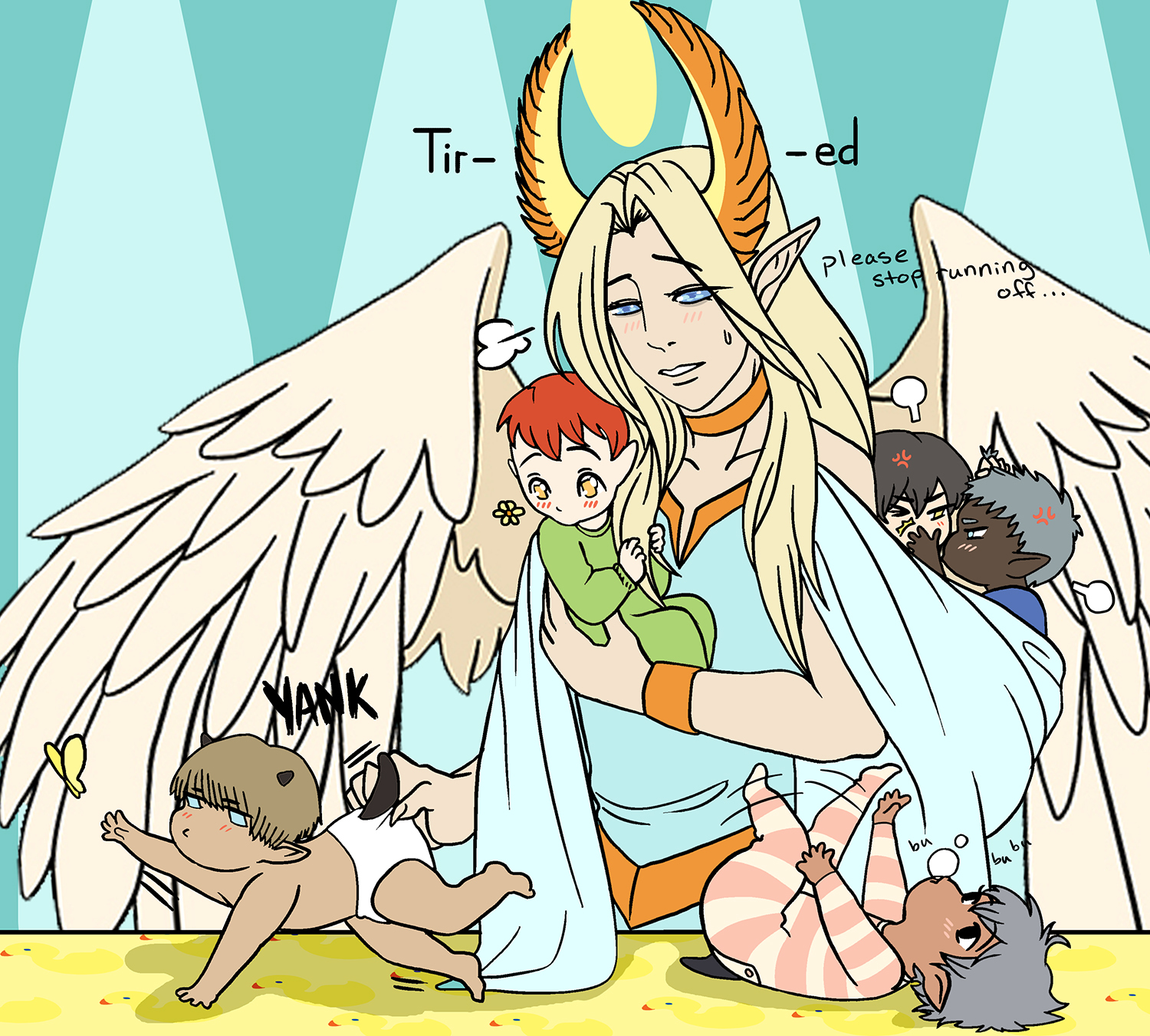Philea
"There's many creatures of desire that we know about, but the details are lacking. What most people don't know is the connection between them. What we call demons, spirits, monsters... There's a number of these that actually share the same origin, even if you wouldn't expect them to be related"
— Philea researcher
Creation & Nestlings
Every single individual of the Phelia species has been created and raised to the age of 18 by Atanu, god of fertility, and his trusted servants. They cannot reproduce naturally. This makes them a very rare encounter and their small population tends to focus around the area Atanu is residing in. However, that does not mean they are infertile. They simply can only have children with non-Phelia which will be the same species as the Phelia's sexual partner.
Young Phelia are not "born" traditionally but created from the life essence Atanu is able to form out of his own energy. They continue to live off of this energy through an invisible bond until they've fully matured. In this early stage they are called Nestlings and have yet to evolve into one of 6 types of Phelia. It is not possible to predict the sub species they are going to become as this is determined by environmental influences and the personality of the Nestling.
Feeding
Since the Phelia haven't been born traditionally they also live off of a different diet than other organisms. To sustain their bodies and power they have to feed on the same kind of life force Atanu used to create them. Currently the only known way to achieve that is by having sexual intercourse with humans or other humanoid species and drawing the energy from them. It is not possible for Phelia to draw this energy from each other.
Feeding not only assures their survival but will also increase their energy level gradually until they eventually reach a secondary stage of their transformation. This second transformation is when they're fully grown and it has great influence on their physical appearance to match their preferences and circumstance, which is why the looks among the same kind of phelia can vary vastly. However, this change will only occur in the moment of transformation and will correspond to subconscious preferences or environmental influences and is not directly affected by the Phelia's decision making. The Phelia's true appearance will not change again after that point unless they get corrupted.
Corruption
While the god of lust, Amrit, the counterpart to the god of fertility, lost the ability to create life when they split into two different entities, he resorted to a different way of creating his own version of Phelia. As he has not a single spark of nurturing in his being he is not at all interested in the reproductive side of carnal desire and started to corrupt and twist the Phelia, making them crave life essence in its purest form; blood.
The process of corruption takes place over the course of approximately 30 days and requires Amrit to feed a small amount of his blood to the Phelia. Would he let them drink the required amount all at once they would die shortly after. During this process not only their appearance tends to get distorted but they lose all memory of their former sense and become a new person, basically resulting in the death of the former individual. The only aspect that remains is their physical and magical strength. Most Phelia actually don't know that the corrupted have been regular Phelia before and just assume Amrit possesses the same power of creation as Atanu.
The Mark
An ability all Philea share once they reach the second stage of their development and learn to use magic is the mark. A symbol they can leave on a partners body like a signature, each symbol unique to their creator. The more powerful the Philea, the more effects it can have. The most basic use of it is to track the individual and claim them for themselves. When they grow stronger they can also signal the individual to come to them, letting them know intuitively where to go. Last but not least a high tier Philea can remotely use their pheromones on them, making it incredibly hard for them not to seek the one who's left the mark. It is a constantly draining ability to use for a Philea, but can create a powerful bond to trap any person they don't want to part with.
Design Notes
Nestlings have stubby tails which will later turn into one of 6 possible outcomes, an incubus' tail, a mermaids fin, etc.
Nestlings have milky pupils that will solidify in shape once they reach the first stage of their transformation. These usually have one out of 3 shapes; round, slits and goat-like. In rare cases the milky pupils stay into adulthood.
Hair, eye and skin color can be pretty much anything. Although most of the time they develop into natural colors similar to humans. Especially unusual skin colors like blue and green are exceptionally rare.
Most physical traits Nestlings develop are already traits of the sub type they are transforming into. However, there's features ALL types of Phelia are able to have, only varying in probability. These include; horns, fangs, claws and tattoo-like markings on their skin, usually covering shoulders, hips and the abdomen. These usually develop once transformation already began but in rare cases of particularly strong Phelia they can also appear in Nestling stage.


If you have any questions, feel free to ask them here in the comments!
3 years, 2 months ago